Controlling Parallelism in Spark by controlling the input partitions by controlling the input partitions
It is useful to be able to control the degree of parallelism when
using Spark. Spark provides a very convenient method to increase the
degree of parallelism which should be adequate in practice. This blog
entry of the "Inside Spark" series describes the knobs Spark uses to
control the degree of parallelism.
Controlling the number of partitions in the "
Spark is designed ground up to enable unit testing. To control the
degree of parallelism in the local mode simply utilize the function
The following snippet of code demonstrates this usage-
Towards the end of the iterations in the
Controlling the number of partitions in the "
Next I will demonstrate how the degree of parallelism is defined in
the server mode. But before I do that let us look at the classes Spark
utilizes to perform its Input/Output functions.
In Chapter 7 of Pro Apache Hadoop 2nd Edition I have discussed the Input/Output framework of Hadoop in detail. I will skip that discussion here.
The call to
Download the following files from this download link of the Airline Dataset
Explode both of the above files in folder on your local machine. I exploded mine in the folder
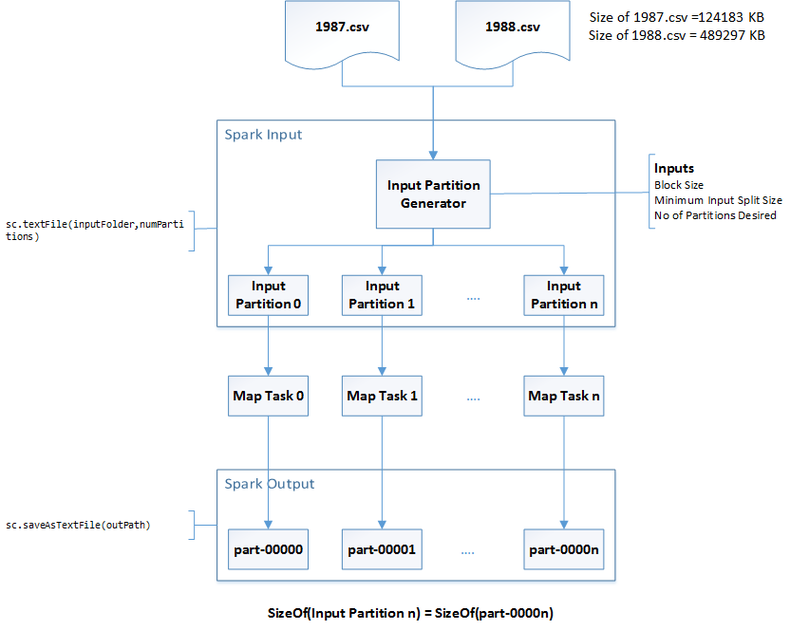
where,
where,
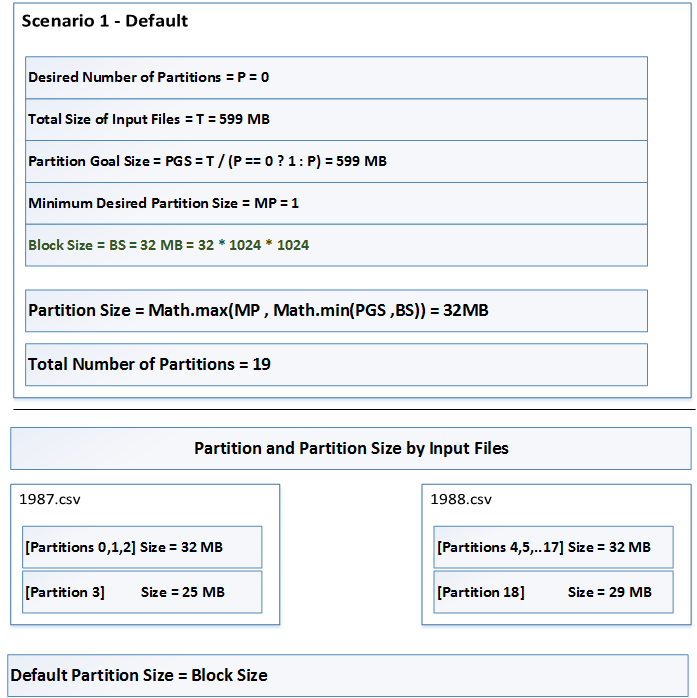
The interesting this to notice here is that each partition belongs to one and only one file. Partition 3 is lower than 32MB because the last 25MB of the 1987.csv are contained in it. Likewise Partition 18 which is 29MB and contains the last block of 1988.csv
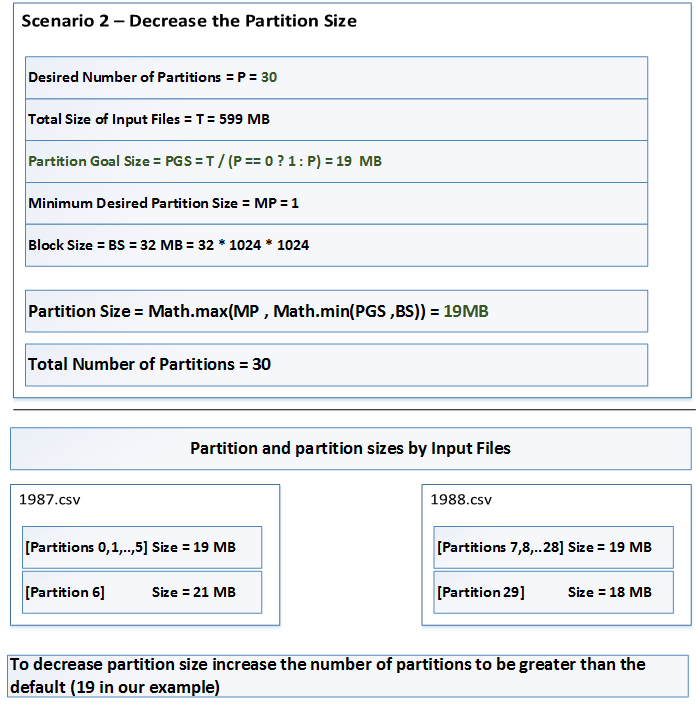
The size of Partition 6 is interesting. It is 21MB. The first 1MB comes from last block of the 1987.csv and the remaining 20MB comes from the first block of the file 1988.csv. In Scenario 1, the partitions can contain entries from multiple files. This is done to respect the value of
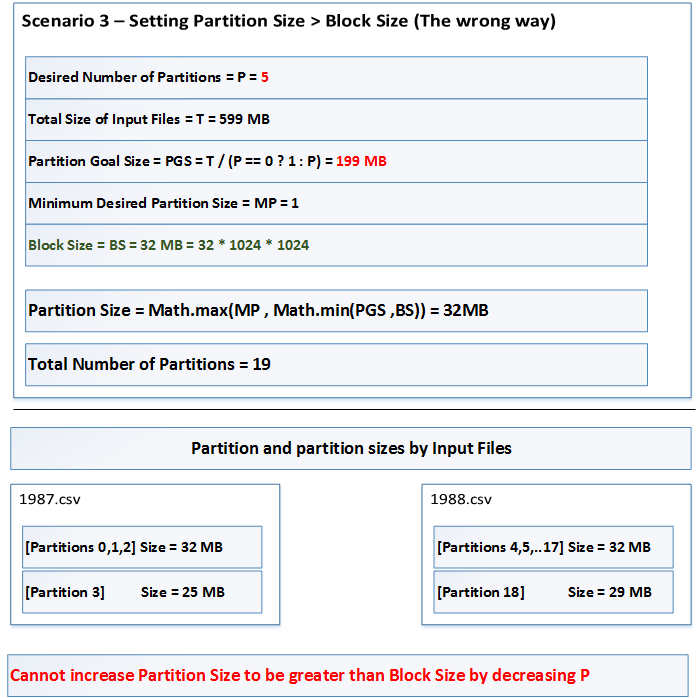
Clearly we cannot increase partition size by decreasing the value of
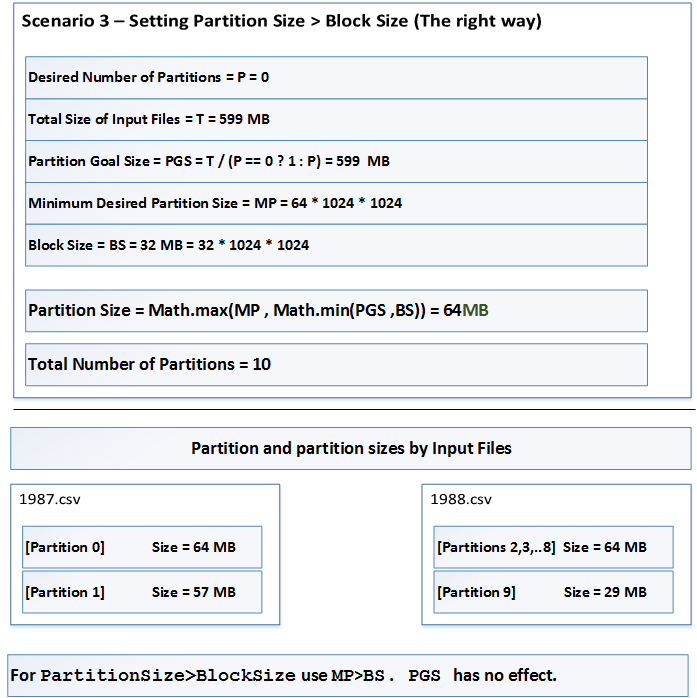
These are part of my Github project.
It takes one parameter,
The four scenarios can be executed by invoking the class
It takes the following 2 parameters
1.
2.
Also remember to pass the system parameter
The four scenario's output will be placed in the following folders
1.
2.
3.
4.
Note: The above classes are implemented using Java 8
The Java 7 version of the class is
If the input files are compressed the degree of parallelism is affected by the type of compression used and if the compression scheme is splittable. Examples of splittable compression schemes are
1. Bzip2
2. Snappy
3. Lzo
An example of non-splittable compression scheme is Gzip. If the input files are Gzip compressed, we will only have as many parallel tasks as the input files and the whole files will be processed in one partition. This can impact not just parallelism but also locality of processing as Spark can no long process each partition on the local node it is stored in the HDFS cluster. This is because the Gzipped file may span multiple blocks which in turn could be stored on multiple nodes.
Controlling the number of partitions in the "local" mode
Spark is designed ground up to enable unit testing. To control the
degree of parallelism in the local mode simply utilize the functionJavaRDD<String> org.apache.spark.api.java.JavaSparkContext.parallelize(List<String> list, int numSlices)The following snippet of code demonstrates this usage-
public class SparkControlPartitionSizeLocally {
public static void main(String[] args) {
JavaSparkContext sc =
new JavaSparkContext("local","localpartitionsizecontrol");
String input = "four score and seven years ago our fathers "
+ "brought forth on this continent "
+ "a new nation conceived in liberty and "
+ "dedicated to the propostion that all men are created equal";
List<String> lst = Arrays.asList(StringUtils.split(input, ' '));
for (int i = 1; i <= 30; i++) {
JavaRDD<String> rdd = sc.parallelize(lst, i);
System.out.println(rdd.partitions().size());
}
}
}
for loop, the
number of partitions will be greater than the number of words.
Consequently the resulting spark RDD will have some empty partitions.
Controlling the number of partitions in the "cluster" mode
Next I will demonstrate how the degree of parallelism is defined in
the server mode. But before I do that let us look at the classes Spark
utilizes to perform its Input/Output functions. Classes participating in the Input/Output?"
Spark uses the same classes as Hadoop to perform its Input/Output. InputFormat/RecordReader class pair performs the Input duties and how the OutputFormat/RecordWriter class pair performs the Output duties in Hadoop.In Chapter 7 of Pro Apache Hadoop 2nd Edition I have discussed the Input/Output framework of Hadoop in detail. I will skip that discussion here.
Inside the JavaSparkContext.textFile(...)
Below are the relevant lines of code from the SparkContext.scala program which configures the Spark Input process.def textFile(path: String, minPartitions: Int = defaultMinPartitions): RDD[String] = {
assertNotStopped()
hadoopFile(path,
classOf[TextInputFormat],
classOf[LongWritable],
classOf[Text],minPartitions)
.map(pair => pair._2.toString).setName(path)
}
textFile delegates to the hadoopFile function which utilizes the TextInputFormat. Note that it uses the old Hadoop API as on the old Hadoop API has the option to define the minPartitions which allows you to increase the partitions than the default. We will soon see that you cannot use this parameter to decrease the partitions to a value lower than the default number of partitions. def hadoopFile[K, V](path: String,
inputFormatClass: Class[_ <: InputFormat[K, V]],
keyClass: Class[K],
valueClass: Class[V],
minPartitions: Int = defaultMinPartitions): RDD[(K, V)] = {
assertNotStopped()
// A Hadoop configuration can be about 10 KB, which is pretty big,
// so broadcast it.
val confBroadcast = broadcast(new SerializableWritable(hadoopConfiguration))
val setInputPathsFunc = (jobConf: JobConf) =>
FileInputFormat.setInputPaths(jobConf, path)
new HadoopRDD(this,confBroadcast,Some(setInputPathsFunc),
inputFormatClass,
keyClass,valueClass,minPartitions).setName(path)
}
Preparing the Dataset for Code Samples
Similar to my previous blog article on sampling large datasets, I will use the Airline dataset for writing code samples in this article.Download the following files from this download link of the Airline Dataset
Explode both of the above files in folder on your local machine. I exploded mine in the folder
C:/MyData/airlinedata/textdata. You should have two files in this folder1987.csv- Size = 124183 KB1988.csv- Size = 489297 KB
Demonstration
To demonstrate how number of partitions is defined at Spark runtime we will run the program depicted in the figure below. We will simulate the "server" mode in the "local" mode to demonstrate how the partition size (and consequently the number of partitions) is determined
Key Parameters participating in the Partition definition process
The key parameters used to control the number of partitions are as followsdfs.block.size- The default value in Hadoop 2.0 is 128MB. In the local mode the corresponding parameter isfs.local.block.size(Default value 32MB). It defines the default partition size.numPartitions- The default value is 0 which effectively defaults to 1. This is a parameter you pass to thesc.textFile(inputPath,numPartitions)method. It is used to decrease the partition size (increase the number of partitions) from the default value defined bydfs.block.sizemapreduce.input.fileinputformat.split.minsize- The default value is 1 byte. It is used to increase the partition size (decrease the number of partitions) from the default value defined bydfs.block.size
Partition Size Definition
The actual partition size is defined by the following formula in the methodFileInputFormat.computeSplitSizepackage org.apache.hadoop.mapred;
/*Import Statements*/
public abstract class FileInputFormat<K, V> implements InputFormat<K, V> {
....
protected long computeSplitSize(long goalSize,
long minSize,
long blockSize) {
return Math.max(minSize, Math.min(goalSize, blockSize));
}
...
}
minSize is the hadoop parameter mapreduce.input.fileinputformat.split.minsizeblockSize is the value of the dfs.block.size in cluster mode and fs.local.block.size in the local modegoalSize=totalInputSize/numPartitionswhere,
totalInputSize is the total size in bytes of all the files in the input path.numPartitions is the custom parameter provided to the method sc.textFile(inputPath, numPartitions)Scenarios
Let us look at how the above mentioned parameters affect the number of partitions (or partition size). For this demonstration the input files and their sizes will be as follows1987.csv- Size = 124183 KB1988.csv- Size = 489297 KB
fs.local.block.size in place of dfs.block.sizeScenario 1 - Default
The default settings arefs.local.block.size= 32 MBnumPartitions= 0 (this defaults to 1)mapreduce.input.fileinputformat.split.minsize= 1 byte

The interesting this to notice here is that each partition belongs to one and only one file. Partition 3 is lower than 32MB because the last 25MB of the 1987.csv are contained in it. Likewise Partition 18 which is 29MB and contains the last block of 1988.csv
Scenario 2 - Decrease Partition Size
The default settings arefs.local.block.size= 32 MBnumPartitions= 30mapreduce.input.fileinputformat.split.minsize= 1 byte

The size of Partition 6 is interesting. It is 21MB. The first 1MB comes from last block of the 1987.csv and the remaining 20MB comes from the first block of the file 1988.csv. In Scenario 1, the partitions can contain entries from multiple files. This is done to respect the value of
numPartitions Scenario 3 - Increasing Partition Size (the wrong way)
The default settings arefs.local.block.size= 32 MBnumPartitions= 5 (lower than 19 as produced in Scenario 1)mapreduce.input.fileinputformat.split.minsize= 1 byte

Clearly we cannot increase partition size by decreasing the value of
numPartitions. Scenario 4 demonstrates the correct way to increase partition size. There
are no situations I know of where increasing partition size is a good
idea, since it will reduce the degree of parallelism. Scenario 3 and
Scenario 4 are only there is illustrate the knobs Spark and Hadoop
utilizes to control partition sizes Scenario 4 - Increasing Partition Size (the correct way)
The default settings arefs.local.block.size= 32 MBnumPartitions= 0mapreduce.input.fileinputformat.split.minsize= 64 MB

Demonstration Classes
The four scenarios above can be simulated by executing the following class from myThese are part of my Github project.
com.axiomine.spark.examples.io.PrintSparkMapSidePartitionSizeControlIt takes one parameter,
inputPath. I have placed the two files (1987.csv and 1988.csv in a folder c:/mydata/airline/txt). When invoked with the parameter c:/mydata/airline/txt the above 4 scenarios can be simulated. This class will only print the partition and their sizes. The four scenarios can be executed by invoking the class
com.axiomine.spark.examples.io.SparkMapSidePartitionSizeControlIt takes the following 2 parameters
1.
inputPath2.
baseOutputPathAlso remember to pass the system parameter
hadoop.home.dir as described in the Note in my earlier blog articleThe four scenario's output will be placed in the following folders
1.
$baseOutputPath/12.
$baseOutputPath/23.
$baseOutputPath/34.
$baseOutputPath/4Note: The above classes are implemented using Java 8
The Java 7 version of the class is
com.axiomine.spark.examples17.io.SparkMapSidePartitionSizeControlFinal Caveats to Remember
The above discussion assumes that the input files are splittable. In our example we used raw text files. The TextInputFormat class that Spark utilizes inside the SparkContext.textFile(...) function is capable of splitting raw text files.If the input files are compressed the degree of parallelism is affected by the type of compression used and if the compression scheme is splittable. Examples of splittable compression schemes are
1. Bzip2
2. Snappy
3. Lzo
An example of non-splittable compression scheme is Gzip. If the input files are Gzip compressed, we will only have as many parallel tasks as the input files and the whole files will be processed in one partition. This can impact not just parallelism but also locality of processing as Spark can no long process each partition on the local node it is stored in the HDFS cluster. This is because the Gzipped file may span multiple blocks which in turn could be stored on multiple nodes.
very nice article,Thank you ..
RépondreSupprimerKeep updating..
Big Data Online Training